Home safety is the main task that is solved at every stage of construction and design. A large number of fires occur due to problems with electrical wiring, so it is the electrician that needs to be given special attention. The wiring must be reliable, serviceable, comply with the rules of the PUE and safety standards, and also correctly selected. To make an independent installation of electrical wiring, you need to follow clear rules and requirements at all stages of work.
DIY wiring installation
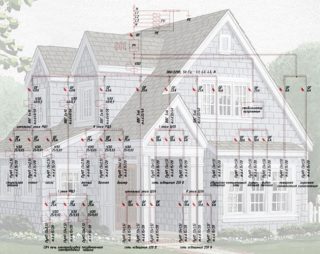
The laying of electrically conductive cables and wires begins after the construction of the roof and walls. You can carry out the installation yourself if the master has the skills to work with electricity, and he also has a professional tool.
If you are not confident in your own abilities, you need to seek help from a professional. Mistake may result in fire or electric shock to family members.
To do the wiring in the house with your own hands, you need to follow the instructions:
- Development of a plan for laying cables and placing power points and electrical devices in the rooms.
- Calculation of energy consumers.
- Selection of appropriate conductors and wiring devices.
- Laying wires on walls and in ceilings.
- Installation of junction boxes, switchboards, sockets and switches.
- Commutation of all electrical parts into a single power grid.
- Performance check, putting the assembled system into operation.
Each step must be performed carefully and accurately. The slightest mistake can lead to negative consequences.
Schema markup
Any work begins with creating a plan. The wiring diagram is created in advance, should contain information about the place of laying the cables, their characteristics, power points, switches. Next, the markup is transferred to the walls. Here it is important to track that there is no contact with engineering systems (gas pipeline, water supply). The presence of heating devices is taken into account, as well as the height of the ceiling and the location of doors and windows.
All wiring lines must be laid vertically or horizontally. With such a layout, the risk of damage to the reins is reduced and it is easier to find an inoperative area in case of need for repair.
Choosing a wiring method
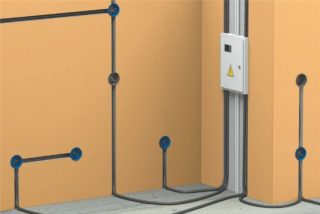
When the plan is created and drawn on the walls, you can proceed to the next stage. There are two ways to do wiring in a private house with your own hands - open and closed installation.
With open installation, all cables are routed along the walls and are visible. This method has its advantages - ease of installation, no need to groove walls, ease of repair. The disadvantages are significant, so they limit the use of this type of installation. They highlight a high risk of damage to cables, an unaesthetic appearance, and the need for high-quality insulation. If the house is made of beams and logs, only open electrification of the house is used. Hidden wiring is prohibited in wooden houses.
In the case of closed wiring, the cables must be routed in the wall in grooves.A similar scheme should be designed at the initial stages of repair work. The advantages include the reliability and safety of wires, invisibility to the eye, durability. Cons - the complexity of installation, the need to make holes in the wall, difficulties in repair. Also, a professional tool is required for chipping.
Preparing the wires
All conductors can be divided according to the material from which the conductors are made. Copper and aluminum are commonly used. Aluminum products are notable for their low price, fragility and fragility. Copper cables are more expensive, but their lifespan is longer. They do not oxidize, they bend more easily, they are easier to spread and they carry more current.
According to the number of cores, single and stranded wires are distinguished. For cottages and private houses, it is recommended to take exactly two- and three-core products. Cables with two cores are used for lighting, with three for connecting electrical equipment and grounded sockets.
The assortment of wires on the market of electrical installation equipment is wide, and users cannot always immediately understand the offered product. Therefore, you should use the recommendations for selection.
You should choose products with double insulation - for example, VVG or PVG with additional marking NG (non-combustible). These are the most affordable devices for house wiring in terms of cost and characteristics. The cross-sections are different, for cottages you will need conductors with an area of 2.5 sq. Mm, 4 sq. Mm. and 6 sq. mm.
Lead-in cable
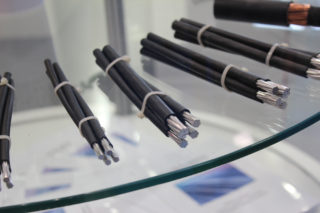
The thickest conductor should be laid on the input. Through it, the entire load from the energy entering the house goes, and then it is divorced into different groups. SIP wires are usually installed from the pole to the electrical panel. This cable is installed by the power supply company, and the owner of the cottage is responsible for laying the site.
In the case of installing the shield on the street, you will need a cable with a cross section of 10-16 sq. Mm. If powerful electrical equipment is installed in the house (electric boiler, air conditioning system, powerful flow and exhaust ventilation), the section must be increased to 16-25 sq. Mm.
Earthing
A grounding system should be designed to improve safety and protect a person from electric shock in the event of a leak. All household appliances are connected to ground outlets. The grounding circuit can be made independently in a private house. It includes an RCD and a drain to the ground. The RCD is placed in the shield itself, and special fittings are selected for drainage, which are driven into the ground.
The entire assembled structure must meet the requirements of PUE. The check is carried out by the power supply service when the system is commissioned. If violations are detected in the connection of the house to the network, they will be refused.
Residual current circuit breaker and circuit breaker
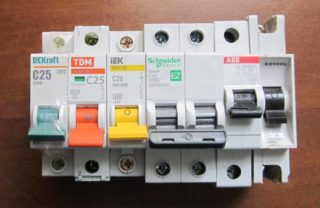
In addition to RCDs, other devices are used for protection - circuit breakers or circuit breakers. They are installed at the entrance and at individual groups of electricity consumers. In the event of an emergency or overload, the circuit breakers de-energize the line. This is the main difference from RCDs, which can turn off the voltage only when a leakage current appears. Differential machines are more expensive and more complex. Outwardly, both devices are similar.
In most cases, one RCD is sufficient for protection. But if expensive and powerful equipment is installed in the house, it is better to additionally purchase automatic machines. Usually a circuit breaker is placed on washing machines, computers, lighting group.
Junction boxes
Junction boxes are an equally important component of home wiring.They are used to connect wires that are supplied from different sides, as well as their wiring. Mounting junction boxes allow you to reliably insulate the contact points of the conductors, protect them from negative effects, including mechanical ones, and also prevent the spread of fire in the event of a fire.
Installation and switching of cables and structures
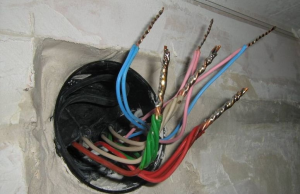
Wire commutation is carried out in several ways:
- soldering, welding;
- terminal blocks with screw and spring terminals.
Soldering is the highest quality, most durable and reliable connection method. But it has its own difficulties associated with the need for a tool and the skills of a master.
Previously, stranding was used. This method is prohibited by the rules of the PUE. Application is only possible together with another method - for example, soldering or welding.
Terminals are one of the most common ways to create a contact. They are easy to use, inexpensive and do not require additional tools. It is important to choose the right terminals and clamps, as they are designed for different materials and different wire diameters.
Connecting sockets, lighting devices
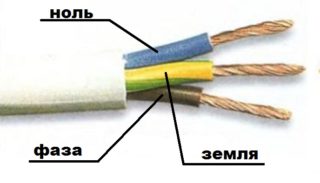
When connecting lighting devices and power points to the general power grid, it is important not to confuse the phase and zero. Appropriate conductors must be connected. Before making a connection, you should make sure what this or that core is responsible for. For this, a check is performed using different testers.
Switchboard
The distribution box is the most complex element in the cottage network. Installation must be performed by a professional, since all currents for the house go through the shield. With minimal error, the risk of problems and malfunctions increases.
The final testing and commissioning of the system should also be done by a specialist. If this is not done, the inspection committee may find problems and will not give permission for electrification. In this case, you will have to re-go through the entire procedure for creating a plan and wiring.









